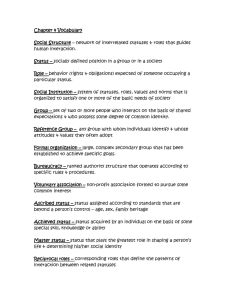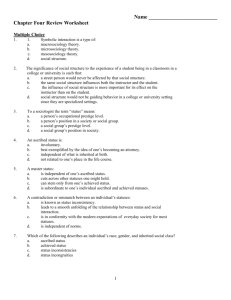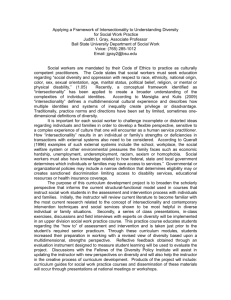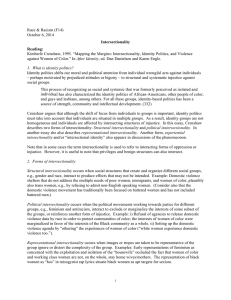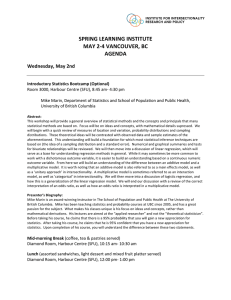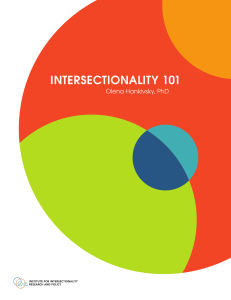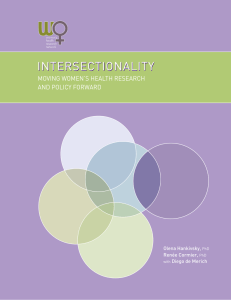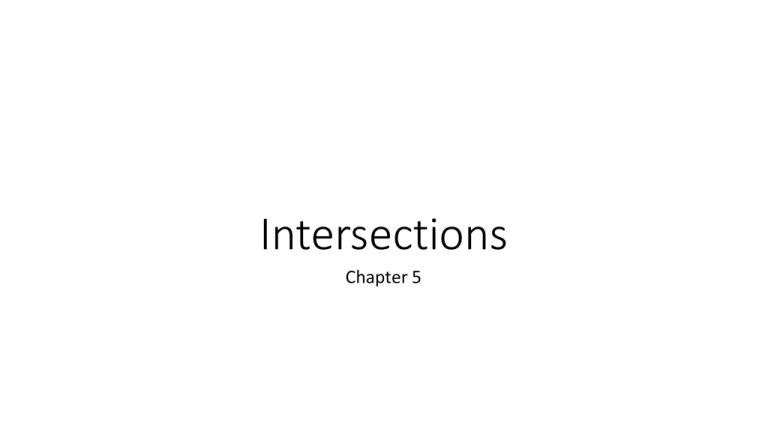
Intersections
Chapter 5
What is Intersectionality?
Intersectionality
• Understanding the intersection of all of our identities
• We don’t just “do gender”…
• What other statuses affect one’s life, opportunities, treatment by others, and
our own identity?
• What is your intersectional status?
Why is an intersectional approach important? What makes it
complicated and difficult to understand?
Intersectionality and the Matrix of
Domination
• How do one’s master statuses converge with oppression and privilege
Gender Strategies
• Finding a way of doing gender that works for us as unique individuals
who are also shaped by other parts of our identity and the complex
realities of our lives
• What are the cultural recognizable masculinities and femininities? What are
the gender stereotypes?
• How and when do we figure out a gender strategy and become ourselves?
Does our gender strategy change? What is this called?
• What affects or gender strategies?
Gender Strategies and Social Class
• America’s wealth and income gaps and high levels of poverty
• Social Class and gender strategies-People carve out a masculinity or
femininity based on social class, work, and life’s twists and turns
• Upper middle and upper class
• -Breadwinner/Wonderful wife and mother model vs the career woman strategy vs dual earner
with high incomes vs stay at home dad models
• Working and middle class
• Dual earner couples-Supermoms-Emasculated dads?-Superdads-Blue collar workers and “real
men”-Country boys and gals and city guys and girls
• Differing masculinities and femininities
Gender and Race
• Race and Ethnicity
• What are the modern day stereotypes showing the intersections of race and
gender:
•
•
•
•
•
•
•
•
•
Black men
Black women
Latino men
Latino women
Asian Men
Asian women
White men
White women
Bi racial men and women
-Aggresiveness vs docility/passiveness? Highly masculine or feminine? Highly intelligent? Criminal?
Hypersexual? Racially unmarked? All American girl? Privileged? Underpriviliged?
How do many fight against or overcome these stereotypes with gender strategies?
Gender Strategies and Sexual Orientation
• Sexual Minorities
• How are gay men and women stereotyped in America? What gay gender strategies
exist?
• Does gender expression always relate to sexual orientation?
• What is “passing”? Why would someone “pass”?
•
•
•
•
Homophobia
Compulsory heterosexuality
Heteronormativity
Homonormativity
• How do gender strategies for gays and lesbians change across culture and history?
What is a survival Strategy?
Gender Strategies and Immigration
• Downward mobility for many immigrants
• Shifting Strategies due to new cultural ideas and differing economic realities
• New Gender roles and ideologies for individuals and couples
• Xenophobia and criminal and sexual stereotypes
• Reconfiguiring sexuality
Gender Strategies and Ability/Disability
• Physical disabilities can interfere with one of our most potent resources for doing
gender: Our Bodies
• Disability and masculinity
•
•
•
•
Class and race intersections
The code of the streets and the tough guy strategy
Money and independence
The “still a man” strategy? Pg 104 examples
• Workaholics
• Disability and femininity
• Denial of the Girly Girl strategy
• Feeling and liberationvs feelings of being in “no womans land”
• “Ever since I’ve been ina wheelchair, I’ve stopped getting catcalled”
Gender and Age and Attractiveness
• As we get older, our ability to pull off different gender strategies
changes…How?
• Gender rules and age rules coincide
• Examples of breaking the rules?
• The double standard of aging
• Ageism
• Overall, gender colludes with our other statuses…gender intersects
with our other salient identities. We carve out strategies and modify
them across time and place managing expectations, constraints and
opportunities
• QUOTE ON LAST PAGE 110

